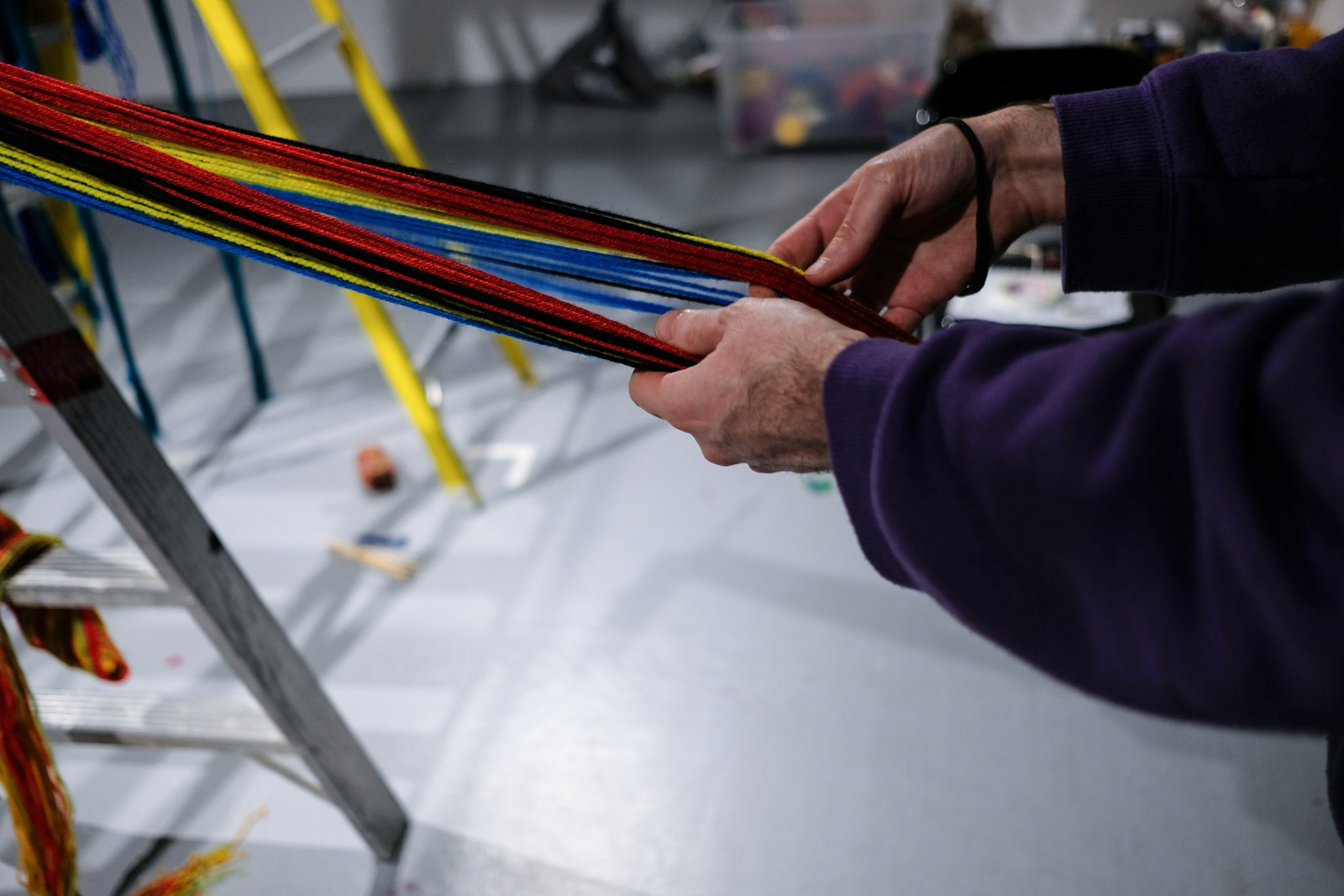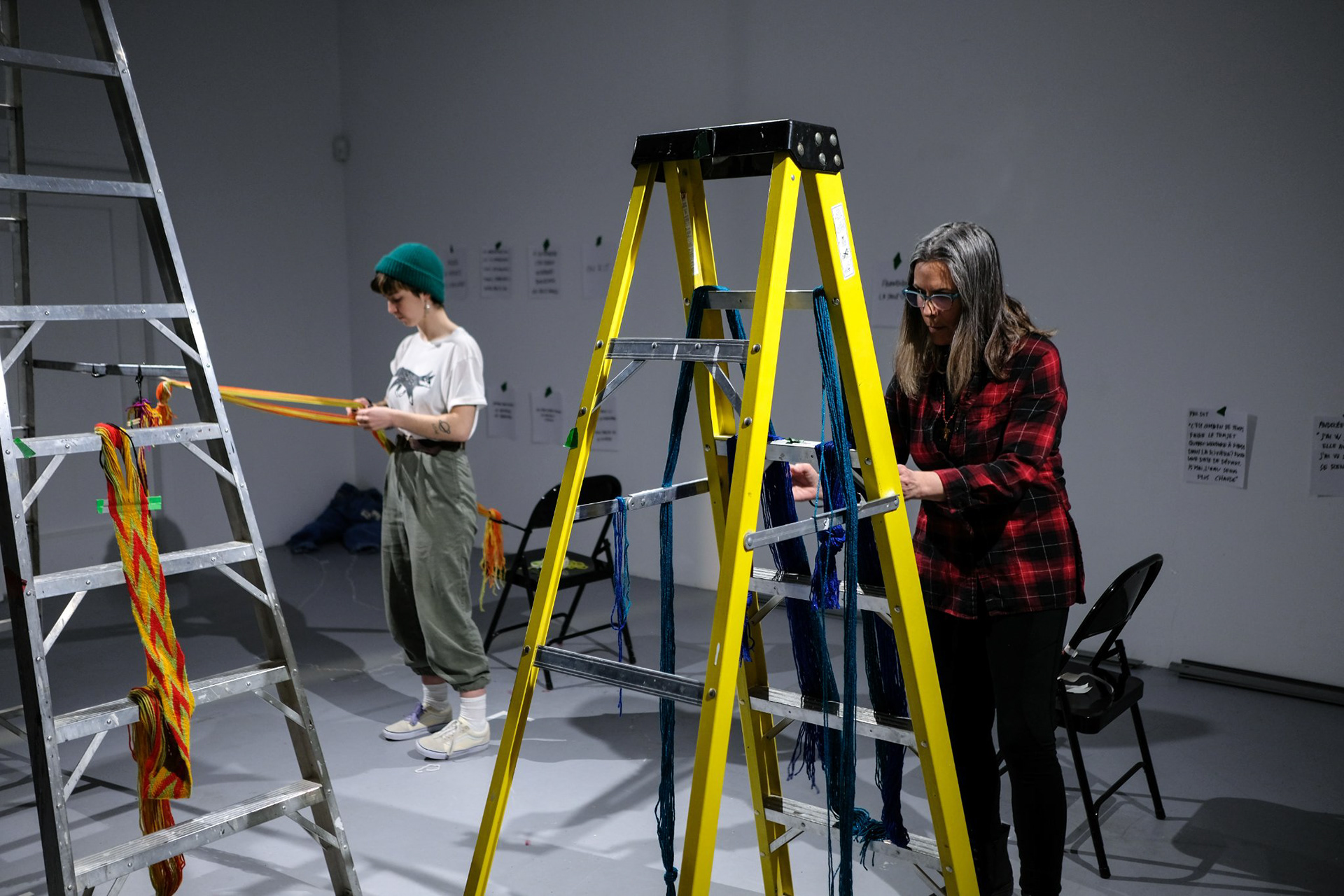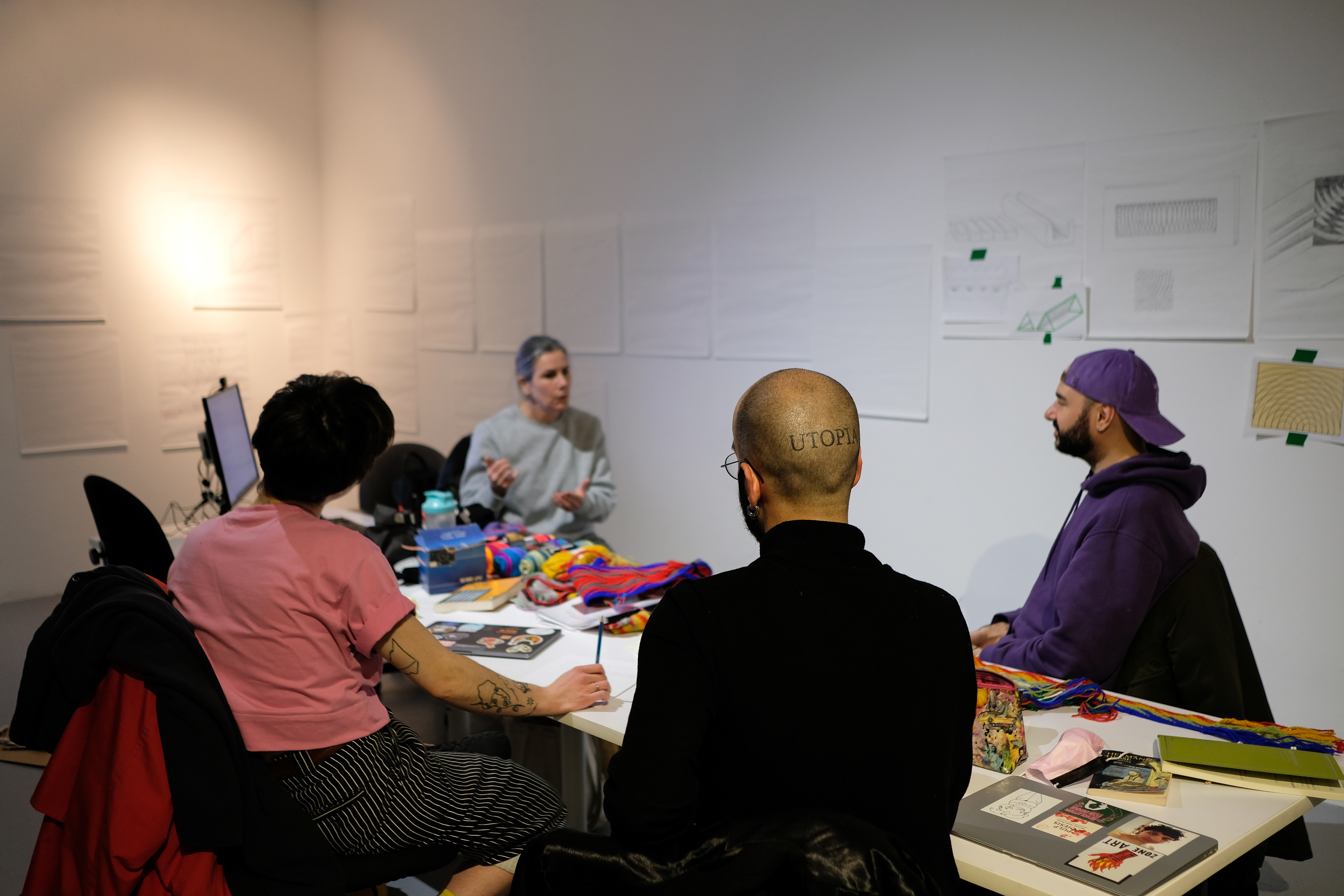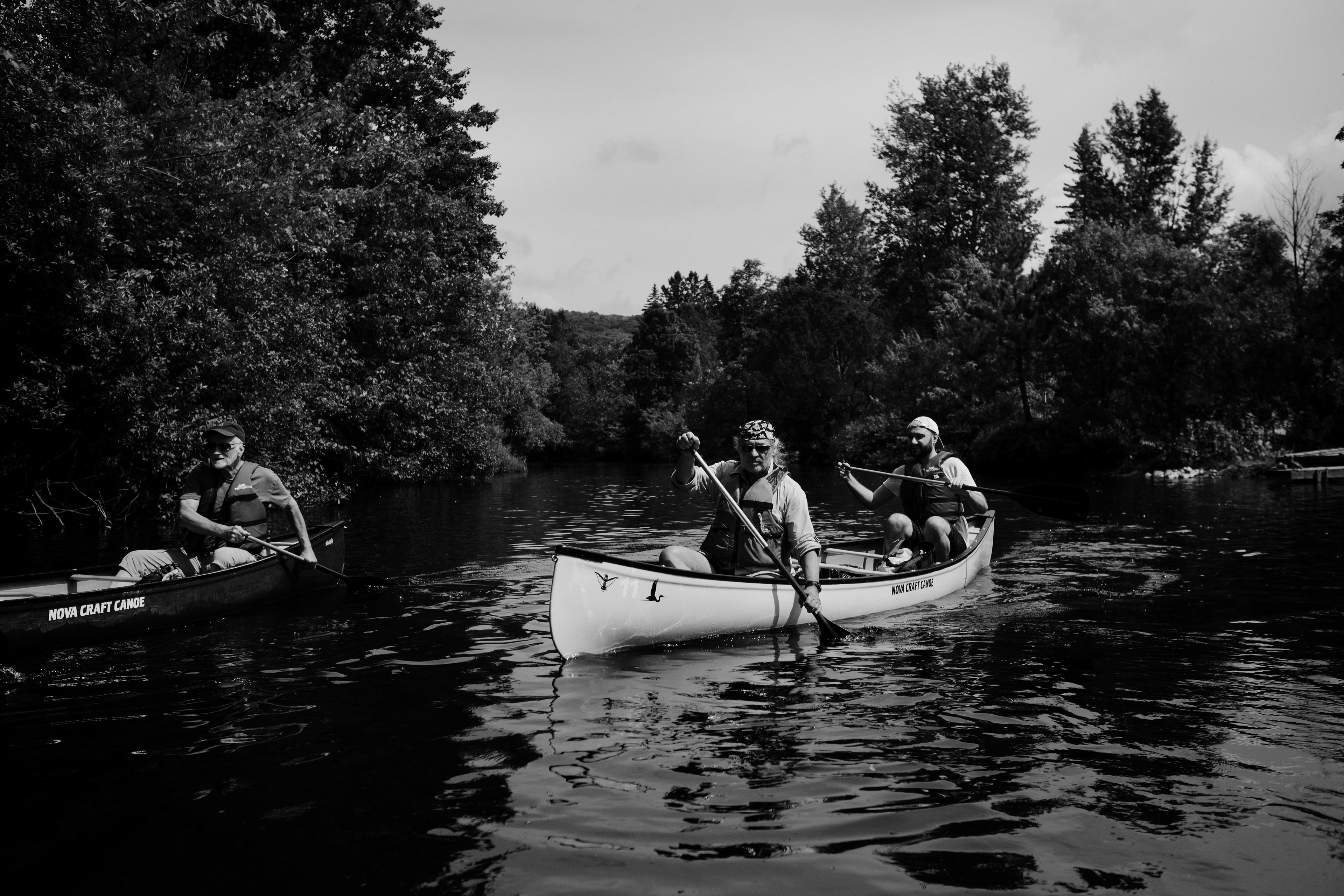






Photos : VU, Debora Flor, Charles-Frédérick Ouellet, Carol-Ann Belzil-Normand, Jeffrey Poirier.
(Extrait du communiqué de VU) : «Yahndawa’ est un échange entre sept artistes de Wendake et sept de Québec, qui ont été appelé·e·s à discuter de leurs pratiques, mais aussi à collaborer et à cocréer, avec le soutien de sept organismes artistiques. Suivant la rivière (yahndawa’) qui relie nos deux communautés – dénommée Atiawenhrahk/la Saint-Charles –, ainsi que l’idée de portages, chacun·e est arrivé·e dans ce projet avec son bagage, qui est ensuite amené sur de nouveaux territoires, avec la complicité des un·e·s et des autres. Depuis 2020, un comité artistique formé de membres du collectif wendat et de VU se réunit régulièrement pour élaborer et faire évoluer ce projet d’échange visant à créer des liens entre nos deux communautés. Yahndawa’ est un échange à propos des pratiques artistiques, mais permet aussi plus largement de se pencher sur nos conceptions, nos façons de faire, nos visions, nos réalités, nos identités.
Les ateliers (été-automne 2021) :
À l’occasion de rencontres à Wendake et à Québec et d’une sortie en canot sur la rivière, les artistes et les représentant·e·s de chacun des organismes impliqués ont pu parcourir ensemble des lieux où convergent nos histoires.
Les résidences (hiver-printemps-été 2022) :
Les artistes ont collaboré pour développer des idées et des projets, avec le soutien technique et artistique des organismes. Le campement, un atelier collectif situé à Méduse, a été occupé par les artistes pour la période des résidences.
Les artistes ont collaboré pour développer des idées et des projets, avec le soutien technique et artistique des organismes. Le campement, un atelier collectif situé à Méduse, a été occupé par les artistes pour la période des résidences.
La diffusion (automne 2022) :
Les artistes présentent le travail qu’il·elle·s ont élaboré tout au long de Yahndawa’ lors d’une exposition à Québec (…) » (du 9 septembre au 16 octobre à Méduse et lors d’un événement intitulé Onyiondih, le 1eroctobre à Wendake, à la Salle Kondiaronk.)
Les artistes présentent le travail qu’il·elle·s ont élaboré tout au long de Yahndawa’ lors d’une exposition à Québec (…) » (du 9 septembre au 16 octobre à Méduse et lors d’un événement intitulé Onyiondih, le 1eroctobre à Wendake, à la Salle Kondiaronk.)
À propos des œuvres :
« Confluences », 2022, présentée à L’Oeil de Poisson, Québec. Installation réalisée en cocréation avec Andrée Levesque-Sioui et Érika Hagen-Veilleux. Laine naturelle québécoise 3 brins (technique du fléché canadien français et chevron), gypse, bois, peinture. 488 x 244 x 91 cm.
« Ondulations : anatomie d’un désordre », 2022, présentée dans la Baie vitrée de Méduse. Image numérique, impression rétroéclairée sur bannière.
Dans le cadre du projet Yahndawa’, le collectif d’artistes formé d’Andrée Lévesque-Sioui, Érika Hagen-Veilleux et Jeffrey Poirier proposent une cocréation faisant écho aux forces inhérentes de la nature et des rencontres humaines ayant marqué leur processus. Inspiré par le dynamisme propre à l’eau et à la géologie, vecteurs et porteurs du portage en lui-même, Jeffrey Poirier à conçu un dispositif géométrique aux qualités architecturales qui schématise ces forces naturelles. L’installation propose une lecture abstraite de ces mouvements et points de rencontre qui traduisent, d’un angle à l’autre, d’un fragment caché à un autre, le concept de portage dans son aspect le plus dynamique. La structure s’offre à voir telle un monolithe massif et délicat, qui réfère à l’aspect incommensurable de la nature et les forces qui l’animent. Le dispositif imaginé par Jeffrey Poirier fusionne avec un ouvrage textile dont la technique fut amenée et enseignée à Poirier et Hagen-Veilleux par Andrée Lévesque-Sioui lors du processus de résidence d’artistes au printemps. L’œuvre met ainsi de l’avant la technique traditionnelle de tressage au doigt de type fléché, qui fut pratiquée à un niveau professionnel de maître par la tante de Lévesque-Sioui et qui fait aujourd’hui partie de la pratique personnelle de l’artiste. Ici amené à un niveau monumental, l’ouvrage de grand labeur réalisé entièrement à la main par les trois artistes mesure 16 pieds de longueur et s’affirme ici avant tout telle une œuvre installative. Habitué à concevoir des œuvres qui questionnent le mode de présentation des objets, Jeffrey Poirier propose ici de réduire la zone de perception des motifs et couleurs de l’ouvrage tissé, laissant planer une spéculation par rapport à ce qu’on ne peut voir, à l’image du milieu aquatique et des limitations de notre perception par rapport à cet environnement. Non pas présenté à la hauteur des yeux habituelle, l’intégration du fragment fléché en milieu de hauteur de l’œuvre vient également défier la perception, affirmant l’aspect sculptural de l’œuvre, tel un tout complet et fusionnel. L’intention de l’artiste en proposant ce type de dispositif géométrique, était également de créer un contraste visuel et conceptuel entre l’aspect souple du fléché et la rigidité du bâti. Cette combinaison imaginée est ainsi un clin d’œil poétique au sillon creusé par la rivière au fil du temps, à ses qualités de liant, de créateur d’écologie, reliant les formes de vie, les communautés. Certes, la technique est ici poussée à un niveau monumental, qui lui confère des qualités quasi-psychédéliques, très picturales, en raison de l’intensité de son accumulation. Qu’il s’agisse des couleurs, des motifs ou autres aspects formels de l’installation, le tout reflète le processus de rencontre, de discussion et de cocréation qui anime et lie les trois artistes complices. Les motifs du fragment fléché de l’installation ont été conçues en écho au milieu aquatique, en référence au concept du projet Yahndawa’ qui signifie « rivière ». Finalement, sur la tranche gauche de l’œuvre, un encadré encastré à même la structure révèle la matérialité brute tout en fils de l’ouvrage, donnant à voir l’origine du processus avant son organisation par le travail physique de longue haleine caractéristique du tressage au doigt. La genèse du projet est ainsi suggérée mystérieusement dans cette ouverture et vient soutenir le jeu de perception cité plus haut.
Photos : VU, Debora Flor, Charles-Frédérick Ouellet, Carol-Ann Belzil-Normand, Jeffrey Poirier.
Excerpt from VU's press release): « Yahndawa' is an exchange between seven artists from Wendake and seven from Quebec City, who were called upon to discuss their practices, but also to collaborate and co-create, with the support of seven arts organizations. Following the river (yahndawa') that connects our two communities - called Atiawenhrahk/la Saint-Charles -, as well as the idea of portages, each one arrived in this project with his or her own baggage, which is then brought to new territories, with the complicity of each other. Since 2020, an artistic committee made up of members of the Wendat collective and VU has been meeting regularly to develop and evolve this exchange project aimed at creating links between our two communities. Yahndawa' is an exchange about artistic practices, but also allows us to reflect on our conceptions, our ways of doing things, our visions, our realities, our identities.
Workshops (summer-fall 2021) : During meetings in Wendake and Quebec City and a canoe trip on the river, the artists and representatives of each of the organizations involved were able to travel together to places where our stories converge.
The residencies (winter-spring-summer 2022) : The artists collaborated to develop ideas and projects, with technical and artistic support from the organizations. The camp, a collective studio located in Méduse, was occupied by the artists for the period of the residencies.
Exhibitions (Fall 2022): The artists will present the work they have developed throughout Yahndawa' at an exhibition in Quebec City (...)» (September 9 to October 16 at Méduse and at an event entitled Onyiondih, October 1 in Wendake, at the Kondiaronk Hall).
About the works :
« Confluences », 2022, presented at L'Oeil de Poisson, Quebec City. Installation co-created with Andrée Levesque-Sioui and Érika Hagen-Veilleux. Quebec natural wool 3 strands (French Canadian finger-weaving «fléché» and «chevron» finger-weaving technique), gypsum, wood, paint. 488 x 244 x 91 cm.
« Undulations: Anatomy of a Disorder ». 2022, presented in the bay window of Méduse. Digital image, backlit print on banner
As part of the Yahndawa' project, the artist collective of Andrée Lévesque-Sioui, Érika Hagen-Veilleux and Jeffrey Poirier propose a co-creation that echoes the inherent forces of nature and the human encounters that marked their process. Inspired by the dynamism of water and geology, vectors and carriers of the portage itself, Jeffrey Poirier conceived a geometric device with architectural qualities that schematizes these natural forces. The installation proposes an abstract reading of these movements and meeting points which translate, from one angle to another, from one hidden fragment to another, the concept of portage in its most dynamic aspect. The structure offers itself to be seen as a massive and delicate monolith, which refers to the immeasurable aspect of nature and the forces that animate it. The device imagined by Jeffrey Poirier merges with a textile work whose technique was brought and taught to Poirier and Hagen-Veilleux by Andrée Lévesque-Sioui during the artist residency process in the spring. The work thus brings forward the traditional technique of arrow finger weaving, which was practiced at a professional master level by Lévesque-Sioui's aunt and which is now part of the artist's personal practice. Here brought to a monumental level, the work of great labor made entirely by hand by the three artists measures 16 feet in length and is asserted here above all as an installation work. Accustomed to conceiving works that question the mode of presentation of objects, Jeffrey Poirier proposes here to reduce the zone of perception of the patterns and colors of the woven work, leaving a speculation about what we cannot see, in the image of the aquatic environment and the limitations of our perception of this environment. Not presented at the usual eye level, the integration of the arrow fragment in the middle of the work also challenges perception, affirming the sculptural aspect of the work, as a complete and fused whole. The artist's intention in proposing this type of geometric device was also to create a visual and conceptual contrast between the supple aspect of the arrow and the rigidity of the building. This imagined combination is thus a poetic wink to the furrow dug by the river over time, to its qualities of binder, creator of ecology, linking life forms, communities. Certainly, the technique is pushed here to a monumental level, which confers on it quasi-psychedelic qualities, very pictorial, because of the intensity of its accumulation. Whether it is the colors, the motifs or other formal aspects of the installation, the whole reflects the process of encounter, discussion and co-creation that animates and binds the three artists accomplices. The motifs of the installation's arrowed fragment were designed to echo the aquatic environment, in reference to the concept of the Yahndawa' project, which means "river". Finally, on the left side of the work, a frame embedded in the structure reveals the raw materiality of the work in threads, showing the origin of the process before its organization through the long physical work characteristic of finger weaving. The genesis of the project is thus mysteriously suggested in this opening and supports the game of perception mentioned above.